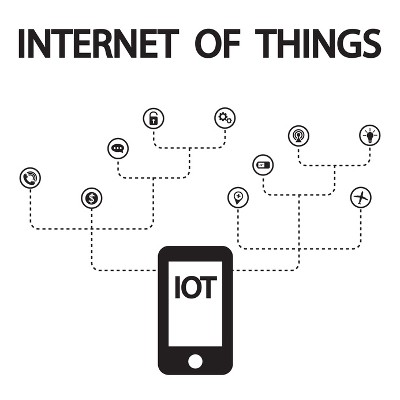If you don’t take measures to secure your email, you could potentially give up crucial information to anyone lurking on the same network as you. This is inevitable on public Wi-Fi connections, or anywhere data is in transit. Encryption is the best way to make sure that your organization’s communications are secure, so you absolutely want to encrypt your email.
Computerware Blog
Depending on your business’ setup, you might have an in-house IT department that manages any of your technological assets, or you might have an outsourced vendor that you prefer to work with. Regardless, you know that as a business owner, you don’t have time to worry about managing IT--especially if you’re a small organization that has a limited budget and a limited workforce to do the work.
The dissemination of data is of vital importance for your business, but do you understand why? Depending on the way your infrastructure is set up, you might be holding your organization back through the use of antiquated technologies. In a lot of ways, advances in technology have allowed businesses to achieve faster connection speeds--particularly in regards to connecting to the Internet.
Does your organization have an internal IT department? If so, you’ve probably noticed that they are too busy problem solving to focus on improving your infrastructure. If they do have time to innovate, chances are they’re neglecting important maintenance. All it takes to improving your infrastructure and operations is, contacting your local managed service provider.
Business continuity is an incredibly important part of running a business, but some smaller organizations underestimate just how crucial it is in the event of a disaster. Although FEMA estimates that more businesses are taking advantage of business continuity than ever before, not enough are. Business continuity is something that must be planned for, practiced consistently, and updated as needed. Does your business have a business continuity plan?
As computing and business have become more intertwined, it has become more important for software solutions and other business-essential tools to be ready at a moment’s notice. This tendency has contributed to the rise of mobile solutions, although there is still a need for the power a desktop provides. That’s why we are big fans of convertible ultrabooks, or 2-in-1 devices.
Imagine working diligently, then being abruptly cut off due to an unpredictable power surge. It would drive anyone to anger, especially if you had just gotten a significant amount of work done. Unfortunately, power surges happen and outages are inevitable, but the least you can do is prepare for them, and minimize downtime and data loss.
Data storage is a major part of running a business, but when it comes to doing so, you have several options. The usual suspect, the hard drive, is what’s most commonly found in both consumer and business environments for a number of reasons. The solid state drive in particular presents unique opportunities for your business that you shouldn’t dismiss.
The cloud trend has been very friendly toward businesses, allowing organizations to fulfill many of their needs and simplify processes that were challenging them only a few years ago. If you’ve never considered the cloud for your organization, it’s time to rethink your choices and ask yourself why you’re hesitant when there are so many great benefits of cloud implementation.
As a small business grows and takes on more employees and adds more departments, one aspect that becomes increasingly difficult to manage is email. Essentially, you go from using a handful of email addresses to managing dozens of accounts. If it feels like you’re losing control of your company’s email situation, then you’ll want to implement the following email solutions.
It’s clear that one of the best ways you can improve your organization’s operations is through investing in new IT solutions, but these expenses change from year-to-year. However, as years go by, the amount that your business invests in IT is sure to shift. Though this year saw a minor decrease in IT spending, Gartner predicts that next year will be another huge opportunity to invest in new technology and IT systems.
Specifically, Gartner predicts a 2.9 percent growth rate in IT expenditures during 2017. ComputerWorld reports this growth as part of a global IT spending of $3.49 trillion. Gartner also predicts that spending on devices will increase by 0.4 percent to an astounding $600 billion. Global software spending growth will exceed 7.2 percent to $357 billion, while IT service spending will increase by 4.8 percent to $943 billion.
This growth is attributed to businesses’ desires to grow and become authoritative figures in their communities and industries--or so says John-David Lovelock from Gartner. He states, “Leading organizations, as well as those that wish to lead, are spending on IT and nurturing their IT investments as the means to grow their business.”
One of the most noteworthy trends in these growing numbers comes from the fact that organizations are increasing their spending while cutting out unnecessary costs. These figures show that businesses want to eliminate unneeded expenses, but also to reinvest the saved revenue into new, more innovative technology solutions. In other words, organizations are attempting to invest their returns to improve operations, and it’s easier to do so than you would initially think.
In fact, this increase in IT spending can mean that businesses are more willing to invest in enterprise-level solutions that create more flexibility and scalability in the workplace, allowing for more growth. The right technology services have an uncanny knack for decreasing capital expenses and freeing up valuable time and resources for more important endeavors. One way that businesses are doing so is by outsourcing services like help desk support and email hosting to third parties in order to free up work hours and reduce their bottom line.
Computerware specializes in outsourced IT, and as such, we want you to know that spending more isn’t always the right answer to maximizing your technology’s ROI. Our proactive managed services seek to reduce capital costs for organizations that want to invest their budget dollars into more lucrative aspects of running a business. In fact, managed services are the ideal way to reduce costs while investing in your business’s future, so why not give them a shot?
For more information, reach out to Computerware at (703) 821-8200.
Every business has hardware, like workstations, servers, and other devices, that are critical to its operational efficiency. However, managing your hardware can be tricky, especially if you’re a small or medium-sized business that has limited time and resources. If your business doesn’t have a process put in to place to handle hardware inventory and deployment, perhaps it’s time that you consider implementing one.
Managed IT services have become a popular way for small businesses to manage their technology. Yet, there are still organizations that mistakenly think they have reasons to prefer the alternative, break-fix IT. In order to show why managed IT is superior, we want to address the top three reasons why a business would lean toward the break-fix model.
“I’ll save money by only fixing technology when it’s broken.”
While at first this seems to be like a common-sense response, look closer. Repairing broken technology when it’s not working as intended is a clear approach, but it’s also highly inefficient. Technology systems deal heavily with data, and as such, your business could be down for days while attempting to resolve problems and maintain systems. This results in wasteful downtime that can easily be prevented.
Plus, you also have to realize that technology costs much more to purchase outright than it does to repair it. Consider this scenario: you have to replace a server unit or a workstation, but the best hardware is quite expensive, and it’s hard on your budget to replace key components whenever they show the slightest hint of degradation. It makes the most sense to invest in quality hardware and maintain it properly, so as to avoid the costly expenses of purchasing new equipment. This is what managed IT seeks to accomplish, and where break-fix IT falls short.
“My technology doesn’t need maintenance regularly.”
Many organizations might still be under the impression that their technology isn’t used enough to warrant regular maintenance routines. They might say this because they only really use their productivity suite, or the Internet browser. The problem lies in the fact that even these applications need constant patches and updates to stay secure from a myriad of threats. When it comes to hacking attacks, you can’t take any risks. If you’ve never had to deal with a data breach, it can seem awfully tempting to dismiss the possibility of a hacking attack.
Herein lies the issue that constantly plagues businesses. More businesses than ever use the Internet, and nobody who uses it is guaranteed to be safe. Any information that’s stored on an Internet-connected computer can be stolen if you don’t take steps to protect it, like implementing a firewall and antivirus solution.
Furthermore, it becomes of critical importance that your team understand the best practices of cyber security. Does this sound like a lot? Managed services can remotely apply patches and security updates, as well as monitor for intrusions; this goes beyond what the typical break-fix IT company can provide.
“My employees and I can handle IT all by ourselves.”
One of the biggest problems that small businesses have is their limited staff. This leads them to cut corners whenever possible, particularly in the IT department. They might feel that employees can handle maintenance and management just fine, and that by allowing them to perform maintenance themselves, they’re saving money.
The problem here is that you have inexperienced users working with technology that they may, or may not, be familiar with. Doesn’t it make more sense to have seasoned professionals working with your technology? Managed IT lets you focus on your business, rather than your technology maintenance.
For more information about managed IT services, give us a call at (703) 821-8200.
The technology research firm Gartner reports that there will be approximately 21 billion devices connected to the Internet by 2020. These devices range from completely benign to essential and everywhere in between. As a result, it would behoove you to know exactly how this computing trend is going to affect your business today, and into the future.
The fact is that you are sure to have some IoT devices already on your network. Whether it be something simple such as an employee’s fitness band, or something significant to the sustainability of your organization, like your heating and cooling systems; near ubiquitous connectivity is here. This technology can provide many benefits, but comes, like any system that’s rife with benefits, with risk. The risk is largely found through foreign software deployment on your network, and can have dire consequences if left unmanaged.
Many of these devices are special in that they communicate with other devices. This is what drives much of the IoT technology, and presents most of the risk. If a device is connected to your business’ network, and can communicate with other devices through that network, it may unwittingly or deliberately share corporate information with those other devices. This makes your network security vulnerable to any number of issues, and while a vast majority of these issues don’t actively put your data at risk, the ones that do can quickly become a full fledged problem.
To mitigate data leakage through Internet of Things supported devices, it’s essential that you understand how to properly administer the deployment of data to these devices. It’s obvious that you cannot just let anyone connect devices to your network, so what are your options?
First, a mobile device management solution can help control which mobile devices can have access to your network and what information they can access if they are allowed on. Secondly, using this management platform, you can design and implement a Bring Your Own Device (BYOD) policy for your organization’s network. This will allow employees to use their own technology in a manner that helps them stay productive, while securing your network from threats such as malware, hackers, and more.
With a mobile device management solution and a BYOD policy in place, you can successfully protect the integrity of your organization’s network, data, and security profile. To learn more about how to manage the risk that Internet of Things devices inherently bring to your network, reach out to us today at (703) 821-8200.
Every business owner is keenly aware of how prominent a role technology has in today’s business environment. Yet, the vast majority of companies aren’t doing enough to keep up with the latest developments, and therefore, risk missing out on serious opportunities for growth, or even going out of business.
Publishers have long provided authors with outlets to share their work. However, just like many other industries, technology has changed publishing over the years. Is this a positive change, and are there lessons that the modern business owner can learn from this shift in the way technology is handled and managed?
Passwords Still Being the Norm
Managing dozens of passwords can be a daunting task, especially if you follow best practices by making a different password for each account, and make sure that every password is complex and hard to remember. One solution is to use a password management tool like LastPass. While this a great way to simplify managing all of your passwords, the fact remains passwords are susceptible to theft. Plus, let’s not forget how annoying it is to navigate to a login page every time you need to access your account.
What makes passwords so frustrating to work with is that, thanks to the range of alternative security tools available on today’s market, passwords should be obsolete. Multi-factor authentication technology and biometric tools like retina and fingerprint scanning are easily available and make for a more secure option, as well as being more convenient to use. Knowing this actually makes it more frustrating when encountering password issues.
Aggressive Promotional Tactics From Technology Vendors
Let’s not beat around the bush here, this is first and foremost a criticism of you, Java and Flash. “Free” apps like this are often times only free because they get paid by sponsors to sneak in extra gimmicks, like annoying browser toolbars (with Yahoo and Ask being two of the worst) or a trial of antivirus software--both of which are difficult to remove once they’re installed on your PC. In most cases, you can opt-out of these “bonuses” during installation, but if you’re in a hurry, it’s easy to overlook this and leave the box check-marked.
This reminds us of another failed promotional tactic by Microsoft: getting users to “make Internet Explorer your default browser” with the aid of a prompt appearing every time you open IE--an approach that’s widely mocked by longtime Microsoft users. Unfortunately, such heavy-handed promotional tactics seem to be the trend for technology vendors, not the exception, which only adds to the frustration of working with technology.
Outdated Technology Still Being Used
It’s 2016 and paperless technology is easy to come by while being super affordable, yet, “modern” offices the world over are still littered with printers and fax machines. Now, as you’ve likely experienced, working with such equipment that’s prone to paper jams bring about a completely new level of IT frustrations--frustrations which can be avoided altogether by instead going with paperless solutions like PDFs, digital signatures, digital scanners, and cloud computing. Typically, businesses that go the route of using outdated and inefficient equipment, do so in an attempt to save money. However, in the end, this strategy actually ends up backfiring when time and productivity are lost.
Websites that Don’t Do What They’re Supposed To
Today’s computing age is heavily dependent upon the Internet, websites, and browsers. Yet, few standards exist for website design and browser functionality, which makes surfing the web an error-filled and maddening experience. Scott Matteson of TechRepublic vents:
Constant updates. Plugin woes. Websites that require you to log in to proceed to view an article but then take you to the home page when you comply. Browsers that don't save credentials no matter how many times you tell them to. Cumbersome site registration with illegible captchas and the requirement to wait for an email to complete setting up your account. (This is getting a better with the opportunity to log in with social media accounts, I'll admit.) The necessity to log your account ID and password somewhere or else use the same one you use everywhere—which is a BIG no-no. The list goes on.
We couldn’t agree more.
At Computerware, we experience our fair share of technology frustrations, and by far, the worst frustrations are akin to the ones listed above because they’re so easily avoidable. We’re sure that you’ve experienced these same frustrations on some level, and we’re here to tell you that IT doesn’t have to be this way! Reach out to us today and tell us about your worst technology grievances. You’ll be happy to learn that we’ll have a technological solution for you to remedy any and all of your IT woes.




















